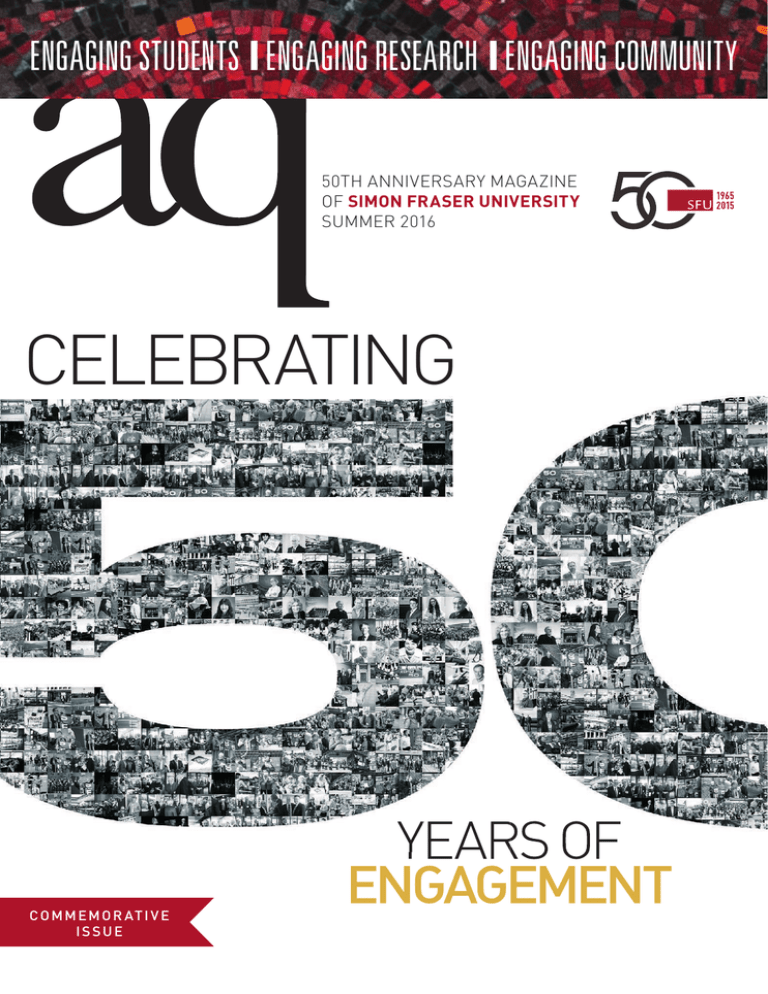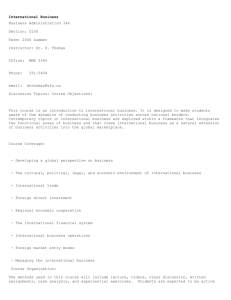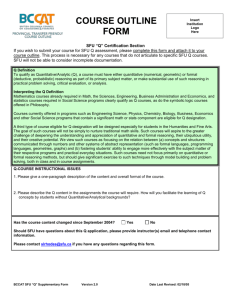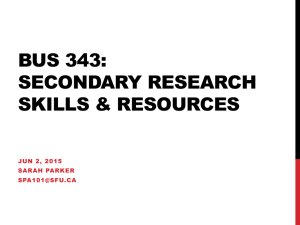CELEBRATING YEARS OF ENGAGEMENT ENGAGING STUDENTS
advertisement

ENGAGING STUDENTS I ENGAGING RESEARCH I ENGAGING COMMUNITY 50TH ANNIVERSARY MAGAZINE OF SIMON FRASER UNIVERSITY SUMMER 2016 CELEBRATING C O M M E M O R AT I V E ISSUE YEARS OF ENGAGEMENT TABle oF coNTeNTs 8 A ToAsT To 50 YeArs Raising a glass to the anniversary celebrations 11 BAck To The FuTure: sFu Through The DecADes Reflecting on 50 years of accomplishments and looking toward the future 23 sFu BY The NumBers Adding up the University’s most engaging stats 24 heADs oF The clAss Spotlighting SFU’s distinguished board of governors over the past half-century 26 BreAkiNg DowN The ivorY Tower History professor emeritus Hugh Johnston explores the relationship between town and gown 32 sFu BookshelF Stacking up SFU’s publishing pedigree Recognizing and respecting our Aboriginal culture 39 BuilDiNg cAmpuses AND commuNiTies Exploring the foundation of innovative education and cutting-edge research 44 sTAYiNg The course Three decades after his passing, Terry Fox continues to inspire 46 50 hours iN The liFe oF sFu Looking through the lens at student life today 52 50 YeArs To The DAY Reminiscing on opening day and honouring today 54 spiriT oF giviNg BAck Those whose generosity has been key to the evolution of SFU 4 p04-05_AQ_contents.indd 4 CLOCKWISE FROM TOP: NIK WEST; PAUL JOSEPH; TERRy FOx FOUNdATION 34 sFu’s wesT coAsT origiNs SUMMER 2016 2016-04-26 3:51 PM coNTriBuTors Editor Art dirEctor crEAtivE Advisor Janine verreault (Ba ’95) stesha ho Catherine mullaly publishEd by contributing writErs Kathleen almeida (Ba ’09), melissa Edwards, ariane fleischmann (m.Pub. ’15), Janet gyenes (Ba ’92), hugh Johnston (professor emeritus), diane luckow (Ba ’78), lisa manfield (Ba ’96), anicka Quin (m.Pub. ’03), allen tung (Ba ’15), Justin Wong (Ba ’15) contributing Artists And photogrAphErs Paul duchard, greg Ehlers, steven hughes, Clinton hussey, Paul Joseph, dale northey, nik West, the Peak Publication society proofrEAdErs EditoriAl AssistAnt sfu contributors melissa Edwards, michael White danika thibault veronica aarstad, ivana filipovic, marianne meadahl ExEcutivE Editors laurie morris, managing director, marketing & Brand management monica Bisal, director, university Communications publishEr Joanne Curry, vice-president, External relations AdvErtising sAlEs Brianne harper phone: 604·299·7311 CLOCKWISE FROM TOP: NIK WEST; PAUL JOSEPH; TERRy FOx FOUNdATION email: sales@canadawide.com PUBLISHED BY ca n a d aw i d e . co m Chairman, CEO Peter legge samantha legge PrEsidEnt PUBLISHED BY Charlene rooke ChiEf COntEnt OffiCEr ExECutivE CrEativE dirECtOr rick thibert dirECtOr/PrOduCtiOn Kim mclane viCE PrEsidEnt /salEs rebecca legge Kirsty senior PrOduCtiOn managEr (on leave) CA NA DA WI D E ME D I A L I MI T E D | caCleggett n a d awide.co m ashley CirCulatiOn COOrdinatOr reproduction of the contents of this issue, except brief passages for review purposes, is forbidden without the express written permission of the publisher. Writer/editor Janet Gyenes (BA ’92) wrote the feature “Back to the Future: SFU Through the Decades” (p.11). What I enjoyed most about this assignment was the chance to go deep into SFU’s colourful history, plus all the nostalgia from my four years at SFU. The most challenging part of this story was trying to encapsulate major accomplishments into sound bites. The most important thing that SFU taught me was to work hard and the rest will fall into place. Photographer Nik West shot the photo essay “50 Hours in the Life of SFU” (p.46). What I enjoyed most about this assignment was that I love shooting photo essays. I love to roam around with my camera in hand and try to capture interesting moments. It’s the freedom to be curious and poke around in places not everyone has access to. The most challenging part of this assignment was that because we shot during the summer, classes weren’t in full swing, so I had to dig deeper. You have to be patient and roam the same areas or wait in a spot and be ready for that unexpected moment to happen. What impressed me the most about visiting SFU was the beautiful campuses, particularly the iconic buildings that make up the main campus in Burnaby. I love architecture. The newer Surrey campus is modern and very cool, as is the downtown Woodward’s campus. There is a mix of new and old, with classes in heritage buildings also. It is an impressive range of spaces. Writer/editor/content strategist Lisa Manfield wrote “Stock Your Bookshelf with SFU Authors” (p.32). What I enjoyed most about this assignment was discovering how many incredible authors are actually SFU alumni like me. The most challenging part of this article was deciding which books to fit in limited bookshelf space! The most important thing that SFU taught me was how to apply my degree out in the world. Doing the co-op work experience program at SFU was one of the best career decisions I’ve ever made and one of the most valuable components of my degree. SUMMER 2016 p04-05_AQ_contents.indd 5 canadawide.com 5 2016-04-26 3:51 PM VISIONARY LEADERSHIP Ian Campbell, hereditary chief of the Squamish Nation, was among 14 students who were the first to graduate from Canada's first credited MBA for Aboriginal leaders. 34 p34-37_First Nations.indd 34 SUMMER 2016 2016-04-26 3:58 PM SFU’S WeSt CoaSt originS SFU haS a rich hiStory oF commUnity engagement with B.c.’S FirSt nationS by Diane Luckow /// portrait by PauL JosePh For decades, faculty members from diverse disciplines have been working with First Nations partners to discover their archaeological history, preserve their Indigenous languages, cultural heritage and intellectual property, and to improve their economic development. Here are just a few success stories and standout initiatives that reflect SFU’s strategic vision to recognize and respect Aboriginal peoples and cultures. SFU.CA p34-37_First Nations.indd 35 SUMMER 2016 35 2016-04-26 3:58 PM PreServing FirSt nationS Culture through language UniqUe eMBa HelpS alUMnUS Blaze neW trailS S FU alumnus Ian Campbell, hereditary chief of the Squamish Nation, is a visionary who has ambitious plans for his people. “We’re moving away from managing welfare to managing wealth,” he says. And now that he has graduated with an SFU Executive MBA in Aboriginal business and leadership, he has the knowledge to forge ahead with ideas for projects. These include developing the Jericho Lands in Vancouver and pursuing development and business collaborations with other First Nations. Campbell, 41, was among 14 students aged 32 to 57 who, in June 2015, were the first to graduate from Canada’s first credited MBA for established Aboriginal leaders, entrepreneurs and others working with Aboriginal communities. In 2013, BCBusiness magazine acclaimed the program as one of B.C.’s 10 most significant innovations. Campbell concurs. He was accepted into SFU’s Beedie School of Business program without an undergraduate degree, but with significant career experience. He says the program “absolutely delivered” on formal business skills and tools while also recognizing and addressing how to incorporate traditional Aboriginal protocols and knowledge. 36 p34-37_First Nations.indd 36 “I’m employed as lead negotiator in intergovernmental relations for the Squamish Nation,” he says. “We’re engaged in significant projects throughout our territory that deal with intergovernmental relations, business opportunities and investment. So my focus in the EMBA was fourfold: creating a vision, structuring our nation’s corporate division, building capacity within the nation and inspiring our young people.” He says the 33-month part-time EMBA program is very timely, and credits SFU’s courage and foresight in creating it. Program director Mark Selman, who conceived and championed the program, says it addresses an important change in B.C.’s business environment. “First Nations are getting access to resources they never had in the past,” he says. “They have money to invest, and opportunities. Businesses are realizing that in terms of managing their risks, they need to work with First Nations.” Adds Campbell, “As Canada goes through reconciliation, we really have to ask ourselves, ‘What are the actions that go with that?’ The leadership SFU exemplified in creating this program has inspired many of our Indigenous groups to move beyond the status quo. We’re now in transition to recreate ourselves—not in isolation but with the rest of Canada.” B.C.’S 30 FIRSt NAtIONS languages are among the most complex intellectual constructs on the planet, but their survival is hanging by a thread, says SFU anthropologist and linguist Marianne Ignace. Ignace is the director of SFU’s First Nations Language Centre (FNLC), and is leading an ambitious seven-year project to work with First Nations community groups to maintain and revitalize some of B.C.'s and Yukon’s Indigenous languages. The project is funded with a $2.5-million grant from the Social Sciences and Humanities Research Council. “The death of each elder who speaks the language represents the irretrievable loss of specific Indigenous ways of speaking, of seeing the world, and of communicating about the land and the physical and social environment,” she says. A professor of linguistics and First Nations studies, Ignace arrived at SFU in the late ’70s from Germany to pursue a PhD on Haida discourse and social organization. She has since played a key role in fostering SFU’s involvement with B.C.’s First Nations, beginning with the establishment in 1988 of SFU outreach courses and programs in anthropology, archaeology, linguistics and First Nations studies. More than 450 students from First Nations communities have since earned credentials such as degrees, diplomas and certificates through these outreach programs. Along the way, she married Shuswap Nation chief Ron Ignace and taught their eight children the nation’s Secwepemc language. She continued to work with numerous Aboriginal groups to document their languages, develop curriculum and create practical grammars. She also created courses to train language teachers and new speakers. Her latest project has been an intensive fourmonth Haida language “boot camp” in the community of Old Massett. The 14 students studied all day, five days a week and Ignace is encouraged by their enormous progress. “The learners’ success gives us hope that through hard work, supported by research, we can together 'grow' a new generation of adults who will continue to develop their fluency as they continue to document their language, gain confidence in using Haida, and teach it to others.” SUMMER 2016 2016-04-26 3:58 PM SFU’S aBoriginal initiativeS FirSt nationS in 2007, the university established its first aboriginal strategic Plan. it aims to create a supportive academic and community environment for aboriginal peoples while also recognizing their values and traditions. since then, exciting aboriginal initiatives can be found throughout the university. These include: • An SFU Strategic Vision that identifies “respect for aboriginal peoples and cultures” as one of its six underlying principles • The Office for Aboriginal Peoples • An Indigenous Initiatives Librarian • An Aboriginal Steering Committee • The Bill Reid Gallery and Bill Reid Centre 1 • A Department of First Nations Studies • A spacious new Indigenous Student centre 2 • A First Nations Language Centre • An Elders Program to mentor Aboriginal students • New scholarships and bursaries for graduate aboriginal students • Improved support for Aboriginal graduate students, including a new indigenous coordinator in graduate studies • More Aboriginal faculty members • Targeted programs, such as the Executive MBA in Aboriginal Business and Leadership • An SFU-led Indigenous Research Centre that fosters indigenous communitybased research, and sponsors an annual aboriginal lecture series 3 1 • Lifelong Learning programs that prepare aboriginal students for university, and for jobs in the health sector • Partnerships with local Aboriginal colleges and organizations such as the native Education College and Nicola Valley institute of Technology • Cultural programming such as the Coast salish drumming and singing workshops • A summer camp for Aboriginal youth • An introductory First Nations course at sFu-affiliated Fraser international college to introduce international students to First nations issues 4 viSUal hiStory The Bill Reid Centre's digital image collection documents the resilience, creativity and vibrancy of northwest coast First nations, from initial contact with europeans to the present. it includes sketches and drawings created by early travellers and explorers, and photographs dating to the mid-19th century. The collection is also a record of the reawakening of northwest coast cultural practices in the late 20th century in the face of enforced policies of assimilation and cultural destruction. The centre’s objective is to engage in community and academic conversations on northwest coast visual culture, and promote public understanding and respect for northwest coast First nations past and present. 2 home away From home The spacious indigenous student centre, which opened in September 2014 at the Burnaby campus, represents a home away from home for more than 600 indigenous students. amenities include a smokeeater for indoor smudging, computers, a dedicated room for the elders Program and student meeting spaces. Planned with assistance from students and community representatives, the $500,000 centre’s wood-and-stone finishes pay homage to the coast salish territories upon which sFu sits. PreP School The aboriginal university Prep Program, established in 2007, prepares aboriginal students for university. The newly revised curriculum features some indigenous texts and works by indigenous scholars, authors and filmmakers. To date, 45 students have completed the program, earning conditional acceptance into sFu and academic credit toward a degree program. 4 SFU.CA p34-37_First Nations.indd 37 3 worldwide reSearch The intellectual Property issues in cultural heritage (iPinch) Program is an sFu-based international research group. Led by sFu archaeologist George nicholas, the research group oversees 15 community-driven projects and has nurtured landmark negotiations on indigenous intellectual property issues between institutions and communities globally. The group earned the social sciences and Humanities Research council of canada’s first Partnership impact award in 2013. ■ SUMMER 2016 37 2016-04-26 3:58 PM



